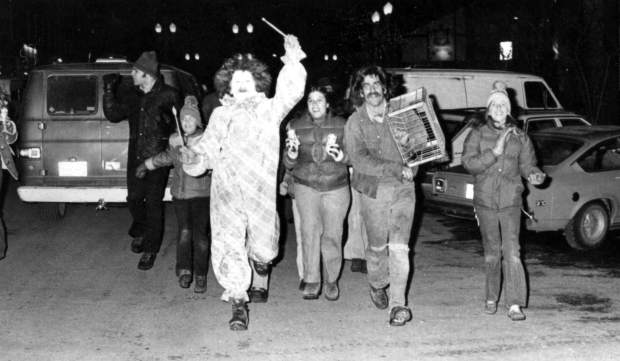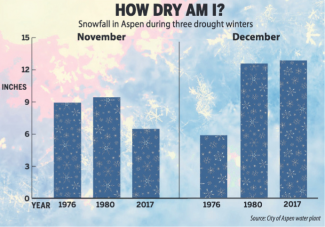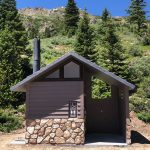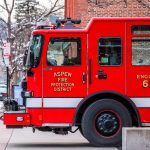Aspen long-timers say drought of 1976-77 was even worse

Aspen Historical Society/courtesy photo |
Bill Kane remembers January 1977 being so dry he piled into a vehicle with then-Aspen Times publisher and editor Bil Dunaway in search of snow.
Two carloads of Aspenites were jonesing for their turns, so they drove over Independence Pass, open well beyond the normal closure, and headed for the deep powder of Taos, New Mexico.
“It was a freakish winter. All the storms tracked south,” said Kane, who was the planning director for the city of Aspen at the time. “It was eerie driving over Independence Pass in January.”
Their willingness to travel paid off. Taos had so much snow the steep chutes and slopes skied like intermediate runs.
“The skiing was pretty good in March but by then nobody was here.” — Jeff Tippett, Snowmass condo manager in 1976-77
“It was the last weekend of January and the first days of February,” Kane said.
While returning after the long weekend, they raced a major snowstorm. They risked crossing the pass and ran into a full-on blizzard at the summit. The road finally closed for the winter the next day.
This winter is “eerily similar” to that legendary drought winter of 1976-77, Kane said. The numbers back it up.
The city of Aspen water plant recorded 9 inches of snow in November and 6 inches in December 1976. That’s just 15 inches to start the season.
This year, 6.8 inches was recorded in November and 13 inches in December, according to water plant data released Wednesday. That’s 19.8 inches to start the winter.
That’s not unheard of in Aspen. In 1943 only 22.3 inches fell in November and December. In 1954 the figure was 20.5 inches.
More recently, another drought hit in 1980 when 22 inches fell in November and December.

But it’s 1976-77 that resonates most with old-timers.
Aspen Mountain wasn’t able to open for Christmas. The Aspen Times ran a now iconic photo of Aspen Skiing Corp. President D.R.C. Brown standing with a shrug in front of the brown slopes of Little Nell.
Buttermilk was bone dry. Snowmass attempted to open Fanny Hill but closed after three hours, according to Tom Egan, a student of all things skiing in Aspen and himself a 21-year-old living at Elk Mountain Lodge up Castle Creek Valley that season.
Aspen Highlands, then independent, made a valiant attempt to open some runs, as recounted in a recent letter to the editor by Andy Hanson.
Robin Perry, head of the Aspen Mountain ski patrol in 1976, said the slopes finally opened Jan. 11.
“There wasn’t any work until a few days before we opened,” he said.
The snow finally started falling in late February and made for decent conditions in March, but by that time, locals had the slopes to themselves.
“Nobody was going out there,” Perry said. “Everybody had about had it.”
For that entire winter, the Aspen water plant recorded 85.7 inches of snow. (The water plant recorded only 59.1 inches of snow in winter 1953-54 but the snowfall total for March is missing.)
Flint Smith was a young ski patroller on the Aspen Mountain crew eager to get on the hill in 1976-77.
“As I recall, many of us went down and filed for unemployment,” he said. “Everybody was kind of hurting at that time.”
But they also kept their sense of humor. Ski patrolman Tim Cooney had a baseball cap made up that said, “Ski The Rock(ies),” Smith recalled.
Longtime Aspen Mountain ski instructor Scooter LaCouter remembered one drought year where snow was taken off the driving range at the Aspen Golf Course to supplement the slopes. As the snow melted, golf balls came to the surface of the ski slopes. (He couldn’t swear it was 1976-77, but it was definitely a drought year.)
Even after snow started falling in 1976-77, the lower slopes were unnavigable for most of the season. Skiers had to walk down Little Nell or download Lift 1A, LaCouter said.
“We did all our skiing up top,” he said. “We’d round Kleenex Corner and popped our skis off.”
Ski instructors and clients who were used to heading to the front of the line to ride up a lift had to pile in with the rest of the folks coming off the hill.
LaCouter said it wasn’t all that bad of season to be a ski instructor.
“There was an awful lot of socializing. I’ll leave it at that,” he said with a chuckle.
For the Colorado ski industry, the winter was a disaster.
It spurred the first round of snowmaking installation. Whichever ski areas didn’t invest in man-made snow systems later paid the price in the drought of 1980-81. Ski-resort economies had too much banking on snow to leave it entirely up to Mother Nature. Many employees had to figure out ways to scrape by.
Linda Harlan was a ski school supervisor at Buttermilk in 1976. She said the Aspen Skiing Corp., as the company was then known, treated its workers well. Buttermilk has the lowest elevation, so it was hit hardest by the drought. Ski instructors weren’t able to teach until fairly late into the season.
“I remember Christmas Day it just poured rain,” she said.
Once instructors were called to work, most were alternating one week on, one week off to give everybody some income.
Before that, the Ski Corp. put them to work picking up rocks on Aspen Mountain’s Little Nell slope and painting ski racks at Buttermilk. Harlan even applied heavy graphite grease to ski bindings at the Buttermilk ski shop. The grease got underneath her fingernails and made it looked like she overhauled an engine, she said.
Jeff Tippett managed a condominium complex in Snowmass Village and still vividly remembers opening day finally came Jan. 19, 1977, at the slopes there. He had to lay off some employees and reduce the hours of those who stayed on. His biggest task, he said, was processing refunds to travelers who canceled their reservations.
“It did start to snow at the end of February,” Tippett said. “The skiing was pretty good in March but by then nobody was here.”
Sam’s Knob opened Feb. 28 that season. He said he caught more air than anticipated on one particular jump and broke through the relatively thin base upon landing. He hit rocks and suffered a compression fracture — adding injury to the insult of the dry season.
Aspenites being Aspenites, they found ways to deal with the drought.
Egan said the skiing was decent above about 9,500 feet in elevation — where Grand Junction is on Aspen Mountain and above Ashcroft in the Castle Creek Valley. But he and his buddies “pointedly didn’t come to town” much because it was depressing. Instead, they would scrape together the $15 necessary to rent a hut in the Fred Braun Hut System, now part of the 10th Mountain Hut System. There was good skiing to be had in the backcountry.
Egan worked one day per week at the Stonebridge Inn at Snowmass Village, but cancellations in the 80 to 90 percent level made it slim pickings. Fortunately, he and a roommate only had to cover monthly rent of $42.50 at a cabin at Elk Mountain Lodge, so the financial strain wasn’t great.
The lower mountain was so dry that season that the torchlight parade on Aspen Mountain for Winterskol was canceled. Egan and about 20 young friends took matters into their own hands and marched down Little Nell in their Sorrels, torches in hand. The few people around to notice greeted them with a cheer at the base, he said.
Everybody interviewed for this article agreed there really is no comparison because of the snowmaking systems in place today. Conditions are much better than 40 years ago. Look at a slope that isn’t covered by snowmaking to get a sense of what all slopes were like in 1976-77, LaCouter said.
Smith said it’s not only the snowmaking but also the quality of the grooming snowcats and the “phenomenal” skills of the drivers that make the biggest difference in the eras. They are able to skim snow off certain areas and fill in bare patches, he said.
That said, everyone agrees we need snow. The current forecast doesn’t include all that much.
For November and December combined, Aspen Skiing Co. recorded 38 inches of snow on Aspen Mountain, 43 inches at Snowmass, 45 inches at Aspen Highlands and 20 inches at Buttermilk, according to Vice President of Communications Jeff Hanle. (More snow drops on the slopes of Aspen Mountain than in the city of Aspen due to the higher elevation.) No data is available for snow on the slopes from 1976-77.
Hanle said the snowfall at Snowmass is about 48 percent of average. The snowpack at Independence Pass was at 56 percent of normal as of Tuesday.
Hanle said Skico is working on contingency plans in case the snow doesn’t come, but none include closing any ski areas.
Tippett noted there are “ugly similarities” in the national weather that season and this one. Both years, the Buffalo, New York, and surrounding region got pounded while Aspenites prayed for snow, he said.
Tippett and his ski buddies are not letting the dry conditions keep them off the slopes this season and are “skiing everyday,” albeit with a calculated selection of slopes and timing.
But they cannot bring themselves to draw comparisons: “It’s something that nobody wants to say.”
After winning Challenger series, Kelly Hilleke on way to becoming valley’s next freeride superstar
The ambitions of a pre-teen can be easy to dismiss, but when Johnny Rossman was coaching the young Kelly Hilleke, he saw a determination to succeed that is rare in someone so far from adulthood.
Injured skier has ‘incredible’ self-rescue below Castle Peak
There wasn’t much Marieta Bialek and Austin Zedak were concerned about.










